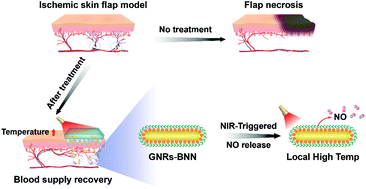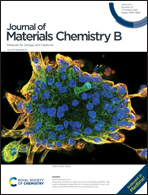Soluble microneedle patch with photothermal and NO-release properties for painless and precise treatment of ischemic perforator flaps†
Abstract
Skin necrosis is the most serious complication of flap plastic surgery, which means the failure of the operation. Systemic administration rarely benefits the local area and can lead to side effects, while topical administration has poor permeability due to the skin barrier function. Currently, few of these common medical interventions can totally respond to the blood supply of the skin after surgery. Herein, a soluble microneedle (MN) patch made of hyaluronic acid was used to target the ischemic area in a painless and precise manner for transdermal drug delivery. Based on the important role of nitric oxide (NO) in angiogenesis, the thermosensitive NO donor (BNN6) and gold nanorods (GNRs) acting as photothermal agents were introduced into the microneedles (MNs). The hyperthermia induced by GNRs under near infrared (NIR, 808 nm) irradiation could enhance the penetration of drugs and facilitate NO release from BNN6. A series of corresponding experiments proved that the system played a significant promotion role in vascular regeneration, providing a painless, precise and NO-assisted treatment method for the ischemic perforator flaps.



 Please wait while we load your content...
Please wait while we load your content...